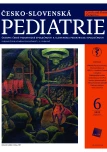Supracondylar fractures of humerus in children – overview
Authors:
Vlach Martin 1,2; Havlas Vojtěch 1; Kautzner Jakub 1
Authors‘ workplace:
Klinika dětské a dospělé ortopedie a traumatologie, 2. lékařská fakulta a FN Motol
1; Ústav chirurgie ruky a plastické chirurgie, p. o., Vysoké nad Jizerou
2
Published in:
Čes-slov Pediat 2022; 77 (6): 362-365.
Category:
doi:
https://doi.org/10.55095/CSPediatrie2022/064
Overview
Supracondylar humeral fractures are one of the most common fractures of childhood in the upper limb. Due to the specific anatomy of the distal humerus and the intimate relationship between nerves and blood vessels, this type of fracture has a higher risk of serious complications. The basis of successful treatment is knowledge of the anatomy and pathophysiology of this injury. Clinical and radiological diagnostics have been well developed over the years. However, opinions on therapeutic approach differ with regard to the experience of individual centres. In particular, the methods of surgical reduction and fixation differ according to the type of fracture. A key aspect of treatment is the precise reduction of rotational dislocations to prevent growth disturbance and elbow function impairment. Subsequent treatment of residual deformities is very complicated, has its own rules and indications, and therefore belongs to centres with extensive experience in this field. The presented text is an overview of knowledge in the field of treatment of supracondylar humeral fractures in children.
Keywords:
Humerus – Elbow – fracture – childhood
Sources
1. Havránek P, et al. Dětské zlomeniny. 2. dopl. a přeprac. vyd. Praha: Karolinum 2013: 115–132.
2. Kapandji AI. The physiology of the joints 1: The upper limb. 7th ed. Fountainhall: Handspring Publishing 2019: 98–107.
3. Barad JH, et al. Range of motion of the healthy pediatric elbow: cross-sectional study of a large population. J Pediatr Orthop B 2013; 22(2): 117–122.
4. Brabston EW, et al. Anatomy and physical examination of the elbow. Oper Tech Orthop 2009; 19(4): 190–198.
5. Skaggs DL, Flynn JM. Supracondylar fractures of the distal humerus. In: Flynn JM, Skaggs DL, Waters PM (eds.). Rockwood and Wilkins’ fractures in children. 8th ed. Philadelphia: Wolters Kluwer Health 2015: 581–628.
6. Popkin CA, Rosenwasser KA, Ellis HB Jr. Pediatric and adolescent T-type distal humerus fractures. J Am Acad Orthop Surg Glob Res Rev 2017; 1(8): 1–10.
7. Goswami GK. The fat pad sign. Radiology 2002; 222(2): 419–420.
8. Mrzena V. Suprakondylické zlomenina humeru u dětí. Postgraduální medicína 2008; 8.
9. Gartland JJ. Management of supracondylar fractures of the humerus in children. Surg Gynecol Obstet 1959; 109: 145–154.
10. Wilkins KE. Fractures and dislocations of the elbow region. In: Rockwood CA, Wilkins KE, King RE (eds.) Fractures in children. Vol. 3. Philadelphia: JB Lippincott Co 1984: 363–575.
11. Leitch K, Kay R, Famino J, et al. Treatment of multidirectionally unstable supracondylar humeral fractures in children. A modified Gartland type-IV fracture, J Bone Joint Surg Am 2006; 88(5): 980–985.
12. Havránek P, et al. Dětské zlomeniny. Praha: Corvus 1991: 64–74.
13. Havránek P. Klasifikace suprakondylických zlomenin humeru u dětí. Acta Chir Orthop Traum Čech 1998; 65(5): 277–288.
14. Mencio GA. Fractures and dislocations about the elbow. In: Mencio GA, Swiontkowski MF (eds.) Green’s skeletal trauma in children, 5th edition. Philadelphia: Elsevier Saunders 2015: 182–240.
15. Dunlop J. Transcondylar fractures of the humerus in childhood. J Bone Jt Surg 1939; (21): 59–73.
16. Charnley J. The closed treatment of common fractures. Edinburgh: E & S Livingstone 1950: 105–115.
17. Havlas V, Trc T, Gaheer R, Schejbalova A. Manipulation of pediatric supracondylar fractures of humerus in prone position under general anesthesia. J Pediatr Orthop 2008; 28(6): 660–664.
18. Novais EN, Andrade MAP, Gomes DC. The use of a joystick technique facilitates closed reduction and percutaneous fixation of multidirectionally unstable supracondylar humeral fractures in children. J Pediatr Orthop 2013; 33(1): 14–19.
19. Tugut A, Aksakal AM, Ozturk A, et al. A new method to correct rotational malalignment for closed reduction and percutaneous pinning in pediatric supracondylar humeral fractures. Acta Orthop Traumatol Turc 2014; 48(5): 611–614.
20. Slongo T. Radialer externer fixateur zur geschlossenen behandlung problematischer suprakondylärer humerusfrakturen typ III und IV bei kindern und jugendlichen. Eine neue chirurgische technik. Oper Orthop Traumatol 2014; 26(1): 75–96.
21. Tošovský V, Stryhal F, Syrovátka A. Dětské zlomeniny. Praha: SZN 1961: 50–82.
22. Arnold JA, Nasca RJ, Nelson CL. Supracondylar fractures of the humerus: the role of dynamic factors in prevention of deformity. J Bone Joint Surg Am 1977; 59(5): 589–595.
23. Mapes RC, Hennrikus WL. The effect of elbow position on the radial pulse measured by Doppler ultrasonography after surgical treatment of supracondylar elbow fractures in children. J Pediatr Orthop 1998; 18(4): 441– 444.
24. Flynn JC, Matthews JG, Benoit RL. Blind pinning of displaced supracondylar fractures of the humerus in children. J Bone Jt Surg 1974; 56(A): 263–272.
25. Fowles JV, Kassab MT. Displaced supracondylar fractures of the elbow in children. J Bone Jt Surg 1974; 56(B): 490–500.
26. Kocher MS, et al. Lateral entry compared with medial and lateral entry pin fixation for completely displaced supracondylar humeral fractures in children. A randomized clinical trial. J Bone Joint Surg Am 2007; 89(4): 706– 712.
27. Fowler TP, Marsh JL. Reduction and pinning of pediatric supracondylar humerus fractures in the prone position. J Orthop Trauma 2006; 20(4): 277–281.
Labels
Neonatology Paediatrics General practitioner for children and adolescentsArticle was published in
Czech-Slovak Pediatrics

2022 Issue 6
Most read in this issue
- Inborn errors of amino acid, organic acid metabolism and disorders of the urea cycle
- Epidemiological and clinical characteristics of paediatric inflammatory multisystem syndrome temporally associated with SARS-CoV-2 (PIMS-TS) in the Czech Republic
- Supracondylar fractures of humerus in children – overview
- Treatment of sleep disordered breathing with non-invasive positive pressure ventilation (NIV) – our experience
